Environment: milieu / climate zone / depth range / distribution range
Ecologia
marinhas associadas(os) a recifes; intervalo de profundidade 5 - 50 m (Ref. 90102). Tropical; 3°S - 27°S, 109°E - 141°E (Ref. 3810)
Eastern Indian Ocean: Aru Islands (Indonesia) and northwest Australia. This species closely resembles Pentapodus setosus and Pentapodus paradiseus.
Tamanho / Peso / Idade
Maturity: Lm ? range ? - ? cm
Max length : 27.0 cm TL macho/indeterminado; (Ref. 9710); common length : 15.0 cm SL macho/indeterminado; (Ref. 3810)
Espinhos dorsais (total) : 10; Raios dorsais moles (total) : 9; Espinhos anais: 3; Raios anais moles: 7. Head scales reaching forward to or almost to level of posterior nostrils. Suborbital naked. Lower limb of preopercle naked. Pelvic fins short, not reaching near level of anus. Upper and lower lobes of caudal fin pointed, more or less equal in length. Axillary scale present. Color: Upper body pale brownish, lower whitish. Presence of three bluish stripes across snout, first joining eyes behind nostrils, second in front of nostrils, third from eye to tip of snout. A yellow stripe from behind eye to upper base of pectoral fin and another running from middle of upper lip.
Occurs close to reefs in offshore waters (Ref. 9785). Solitary or small groups (Ref. 90102).
Life cycle and mating behavior
Maturities | Reprodução | Spawnings | Egg(s) | Fecundities | Larvas
Russell, B.C., 1990. FAO Species Catalogue. Vol. 12. Nemipterid fishes of the world. (Threadfin breams, whiptail breams, monocle breams, dwarf monocle breams, and coral breams). Family Nemipteridae. An annotated and illustrated catalogue of nemipterid species known to date. FAO Fish. Synop. 125(12):149p. Rome: FAO. (Ref. 3810)
Categoria na Lista Vermelha da IUCN (Ref. 130435)
Ameaça para o homem
Harmless
Utilização humana
Pescarias: pescarias de subsistência
Ferramentas
Relatórios especiais
Descarregue XML
Fontes da internet
Estimates based on models
Preferred temperature (Ref.
123201): 26.4 - 28.7, mean 27.9 °C (based on 182 cells).
Phylogenetic diversity index (Ref.
82804): PD
50 = 0.5002 [Uniqueness, from 0.5 = low to 2.0 = high].
Bayesian length-weight: a=0.01479 (0.00706 - 0.03101), b=2.97 (2.80 - 3.14), in cm total length, based on LWR estimates for this (Sub)family-body shape (Ref.
93245).
Nível Trófico (Ref.
69278): 3.6 ±0.5 se; based on size and trophs of closest relatives
Resiliência (Ref.
120179): Elevada, tempo mínimo de duplicação da população menor que 15 meses (Preliminary K or Fecundity.).
Fishing Vulnerability (Ref.
59153): Low vulnerability (17 of 100).
Nutrients (Ref.
124155): Calcium = 57.7 [35.1, 116.1] mg/100g; Iron = 0.656 [0.321, 1.603] mg/100g; Protein = 19.1 [17.2, 20.8] %; Omega3 = 0.155 [0.093, 0.259] g/100g; Selenium = 29.7 [17.8, 53.1] μg/100g; VitaminA = 78.1 [22.6, 222.5] μg/100g; Zinc = 1.24 [0.86, 1.78] mg/100g (wet weight);
